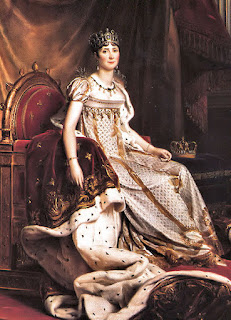 You may find these images disturbing or macabre, however, as the inventor of the daguerreotype in 1839, I attest they were not created with this intention. On the contrary, they were keepsakes of loved ones, proudly displayed in the home and circulated amongst friends and family. This young girl in her new dress has a circlet of flowers on her head, a bouquet at her shoulder, and one single blossom in her hand. Flowers held meaning for the Victorians, and a forget-me-not would be a most appropriate choice. Planks of wood in the background, may have been leftover lumber from the coffin's construction.
You may find these images disturbing or macabre, however, as the inventor of the daguerreotype in 1839, I attest they were not created with this intention. On the contrary, they were keepsakes of loved ones, proudly displayed in the home and circulated amongst friends and family. This young girl in her new dress has a circlet of flowers on her head, a bouquet at her shoulder, and one single blossom in her hand. Flowers held meaning for the Victorians, and a forget-me-not would be a most appropriate choice. Planks of wood in the background, may have been leftover lumber from the coffin's construction. Infant mortality was high, especially in cities with poor sanitation and dirty water. An often overlooked cause of death was the use of narcotics to quiet bawling infants. Godfrey's Cordial, a mixture of opium, treacle, water, and spices was a favorite of working class mothers. In Manchester, England, five out of six families dosed their infants with opium.
Infant mortality was high, especially in cities with poor sanitation and dirty water. An often overlooked cause of death was the use of narcotics to quiet bawling infants. Godfrey's Cordial, a mixture of opium, treacle, water, and spices was a favorite of working class mothers. In Manchester, England, five out of six families dosed their infants with opium. Because my artistry of photography was expensive, most families may not have had an opportunity to capture a young child's likeness before they died. I often posed my subject as if they were alive, clutching a favorite toy. At times, I painted the pupils on the closed eyelids, or on the print itself. In this case, a rosy glow is added to the cheeks with great effect.
Because my artistry of photography was expensive, most families may not have had an opportunity to capture a young child's likeness before they died. I often posed my subject as if they were alive, clutching a favorite toy. At times, I painted the pupils on the closed eyelids, or on the print itself. In this case, a rosy glow is added to the cheeks with great effect. It's unknown what horrible catastrophe wiped out this entire family, but epidemics of cholera, tuberculosis, influenza, and smallpox went unchecked in overcrowded cities. Death by sickness was at a level not seen since the Black Death of the Middle Ages.
It's unknown what horrible catastrophe wiped out this entire family, but epidemics of cholera, tuberculosis, influenza, and smallpox went unchecked in overcrowded cities. Death by sickness was at a level not seen since the Black Death of the Middle Ages. Living children often posed with their dead siblings. Due to the long exposure time, I had to ask my subjects to remain motionless for three to fifteen minutes.
Living children often posed with their dead siblings. Due to the long exposure time, I had to ask my subjects to remain motionless for three to fifteen minutes.  Keen on capturing the essence of an individual, I, would at times, go to great lengths. This gentleman was able to maintain his noble bearing with the help of a steel rod attached to his back, and wires positioning his arms. A close-up of his eyes reveals the vacant stare of death.
Keen on capturing the essence of an individual, I, would at times, go to great lengths. This gentleman was able to maintain his noble bearing with the help of a steel rod attached to his back, and wires positioning his arms. A close-up of his eyes reveals the vacant stare of death.Unfortunately, with the advancement of photography, and thus the resulting economy of capturing one's likeness, memento mori is no longer in vogue.
(Dear Gentle Reader, Please post your comment regarding this fascinating Victorian art form.)

















